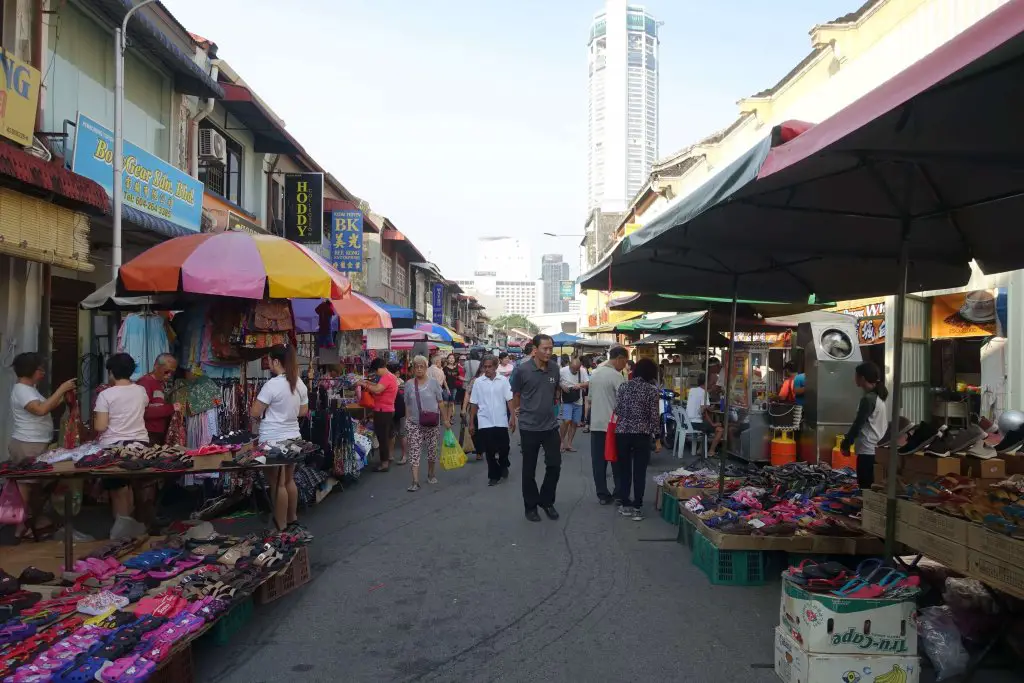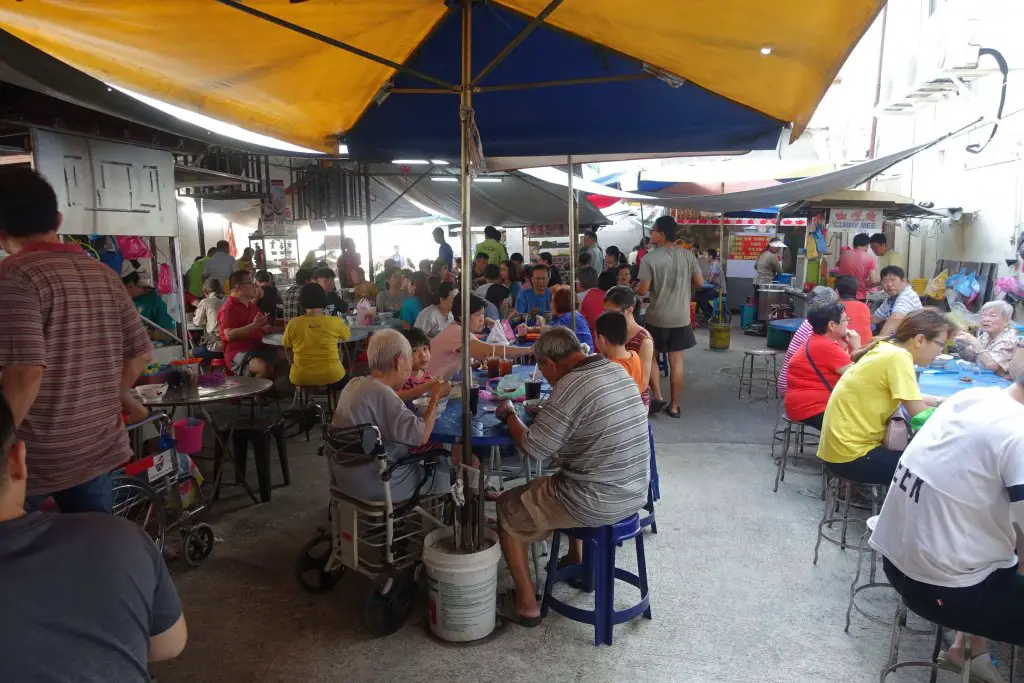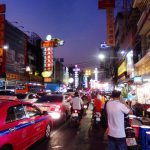Been to Penang a couple of times before, but first time I’m attempting to write about it! George Town itself is worth a few days for the food, historical sights, street art and more. But if you’ve gotta squeeze the highlights into one day, here’s how it might be done. This itinerary can be completed on foot. Best done in good weather!
Breakfast at Chowrasta Market
Start the day right with breakfast at Chowrasta Market. In the morning stalls spill onto the streets around the market building. The bustling streets sell an array of household goods but most importantly, food. There are a couple of sections selling food, and definitely more choices than your stomach will allow.
Muntri Street (Lebuh Muntri)
After breakfast and walking around the morning market, head northeast along Jalan Penang and at the junction with Chulia Street (Lebuh Chulia), turn on to Leith Street (Lebuh Leith). The next junction is with Muntri Street and is next on this itinerary. There are a couple of nice looking buildings along this street. Starting from the junction with Leith Street …
Slightly further in Muntri Street is Thean Hou Temple, a Hainanese temple. This temple was started in 1895. Hainanese were seafarers back in the days, and this temple is dedicated to the goddess of the sea, Mazu. The temple was restored in 1995 to mark its centenary, and you can see the fine stone carvings around the temple from this restoration. Around the temple you can also see the legacy of the Hainanese community, with the Penang Hainan Association to the left, and Aik Hua school, established by the community, to the right.
If you’re up for more walking head another 100m or so in and you’d see Penang Ta Kam Hong temple on your right, alongside the huge mural on the wall. Penang Ta Kam Hong is the Penang Goldsmith Association. The association was founded in 1832, and the association building/ temple constructed in 1904. The artwork on the wall to the right is ‘Little Girl in Blue’ by Ernest Zacharevic, painted in 2012. Lots of street art all over George Town, and they’re worth a tour on their own.

Blue Mansion/ Cheong Fatt Tze Mansion
Next, backtrack to Leith Street and continue in the northeast direction. Just slightly further down is Cheong Fatt Tze Mansion, more commonly known as the Blue Mansion. Most people come to here for a tour of the grand residence, one of the top highlights of George Town, but there are also fine dining and exotic accommodation options available for those with deeper pockets. You’ll have to go on one of the guided tours around the mansion, so it is only opened at specific slots in the day. This is important to note and depending on what time it is you may want to skip to the next part of the itinerary and come back again later. The tour timings are: Mondays to Fridays, 11am, 2pm and 3.30pm; Saturdays and Sundays, 11am and 2pm. The tour is 45 minutes long and costs 16 RM.
The Blue Mansion has quite a history and its share of highs and lows. Inside, the design, furnishings and layout were beautifully restored. I’d definitely recommend giving this a visit.
Against this stunning backdrop it’s no wonder that more than a handful of filmmakers have set their movies here, most recently and notably Crazy Rich Asians. My favorite feature was the central courtyard. Here’s a look around it.
Lebuh Farquhar
After Cheong Fatt Tze Mansion, continue on the same direction along Leith Street. Farquhuar Street, or Lebuh Farquhar, is at the end of Leith Street. Then, head right (eastwards) along Lebuh Farquhar.
Lebuh Farquhar is named after Robert Townsend Farquhar, who was second Lieutenant-Governor of present day Penang from 1804 to 1805. This Farquhar is not related to William Farquhar, the first British Resident and Commandant of Singapore. Along Lebuh Farquhar you’d see colonial buildings and institutions established during the years of British rule. Here are just 2 of these grand old buildings, but if you’ve time there’s more to check out along the street.
Church of the Assumption
The Church of the Assumption was the first Roman Catholic Church in Penang, and the third oldest Catholic church in Malaysia. It was first established in 1786, and the present church was constructed in 1860. The Church of the Assumption is a world heritage church and was most recently restored in 2016. In the context of churches in the region the architecture looked unique. More about the church on their website here.
St George’s Anglican Church
St George’s Church is the oldest Anglican church in Southeast Asia and was built in 1818. It is also a UNESCO World Heritage Site and one of 50 National Treasures of Malaysia. Really elegant and photogenic church. I spent some time on the lawn in front trying out different angles.
Green Mansion/ Pinang Peranakan Mansion
To get to the next stop, continue along Lebuh Farquhar till the end of the road. Turn right at Jalan Masjid Kapitan Keling, then left 2 junctions later at Lebuh Gereja (Church Street). After 3 junctions (220m) you’ll find the Pinang Peranakan Mansion, also known as the Green Mansion.
The Pinang Peranakan Mansion was a residence built by Chung Keng Quee in the 1890s. Chung Keng Quee was one of the richest men in Penang; a successful businessman, philanthropist, and a secret society leader who had close ties with the British. The mansion fell into neglect decades later. In the 1990s it was restored, and today it houses a private collection of Peranakan antiques. The restored building is a marvel, and the collection is really impressive considering it is a private one. Entrance to the mansion is RM 20. It is opened Mondays to Sundays 9.30am to 5pm.
There are free guided tours of the mansion and museum collection. Having walked a round on my own before joining the tour, I’d recommend joining one of these tours as it made a significant difference to my understanding and appreciation of the mansion and artifacts. As with Cheong Fatt Tze Mansion there is a beautiful central courtyard with skylight.
At the back of the main building, a narrow alley leads to the ancestral worship hall. Though just separated by a doorway it was like stepping into another world. Noise from the outside world seem to fade away. Intricate carvings lined the walls and roof depicting scenes beyond my understanding, but I was amazed nonetheless.
Over at another side of the compound is where most of the Peranakan artifacts are displayed. The collection had some really exquisite items, probably worth a lot, with things handmade of kingfisher feathers, ivory and gold.
Little India
The neighborhood just to the southwest of Pinang Peranakan Mansion is the ethnic Indian enclave in Penang, Little India. Early immigrants from southern India settled in this area. The oldest Hindu temple in Penang, Sri Mahamariamman Temple, built in 1833, is also located here. Little India is a colorful and lively place for an afternoon stroll.

Little India. 
Sri Mahamariamman Temple. 
Han Jiang Ancestral Temple.
Jalan Masjid Kapitan Keling
Back on Jalan Masjid Kapitan Keling, one of the streets bordering Little India, are a couple of interesting religious sites.
Goddess of Mercy Temple
This is actually a short detour on the way between St George’s Cathedral and Pinang Peranakan Mansion, but not far from Little India too. The Goddess of Mercy Temple is the oldest Taoist temple in Penang, being built in 1728. It was originally dedicated to Mazu, the goddess of the sea, but with the influx of various Chinese ethnic groups, other deities were added over time. Eventually Guanyin, the Goddess of Mercy, became the main deity of the temple. Historically, the temple played an important role in the early days, mediating frequent feuds between the different Chinese ethnic groups.
Masjid Kapitan Keling (Kapitan Keling Mosque)
Masjid Kapitan Keling was built in the 1800s for the Indian Muslim community in George Town. It’s quite a grand mosque, pretty unmissable along Jalan Masjid Kapitan Keling, the road named after it.

Yap Kongsi
Continuing towards the end of Jalan Masjid Kapitan Keling, a neat row of houses stand out along Lebuh Armenian. Just at the junction is the clan association and temple of the Yap surname, Yap Kongsi. Throughout George Town there are many clan associations for each of the prominent surnames. 2 of the more well known clan associations in George Town are Khoo Kongsi and Cheah Kongsi, which are also in the area. Both Khoo Kongsi and Cheah Kongsi are much larger and grander and are worth a visit. These clan association seem to suggest a high emphasis the Chinese migrants place on family ties and having a sense of belonging, despite being far away from home.
Follow along Lebuh Armenian, gracefully flanked by old shophouses, as the road leads inwards towards the city center.

Kimberley Street Food Night Market
After that whole day of walking it’s time for a feast. Kimberly Street Night Market is just around the corner. You’d be able to get just about any of Penang’s delights here. Don’t fill yourself to the brim at the first stop though, along the road there are a few stops you can make to try out more flavors.
To get there from the previous stop, continue along Lebuh Armenian till the end, turn right on to Lebuh Aceh, left on to Lebuh Carnavon and one block down, turn right in to Lebuh Kimberly.
The end of Lebuh Kimberly is a stone’s throw from Pasar Chowrasta, where we began the day at. The complete circle complete’s this one day itinerary of George Town, definitely not covering all the main sights but likely most of it. Of course, Penang is also known for its amazing food, so coming up next, some ideas on where/ what to eat in Penang!
























































